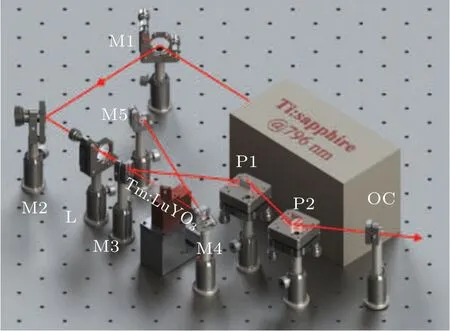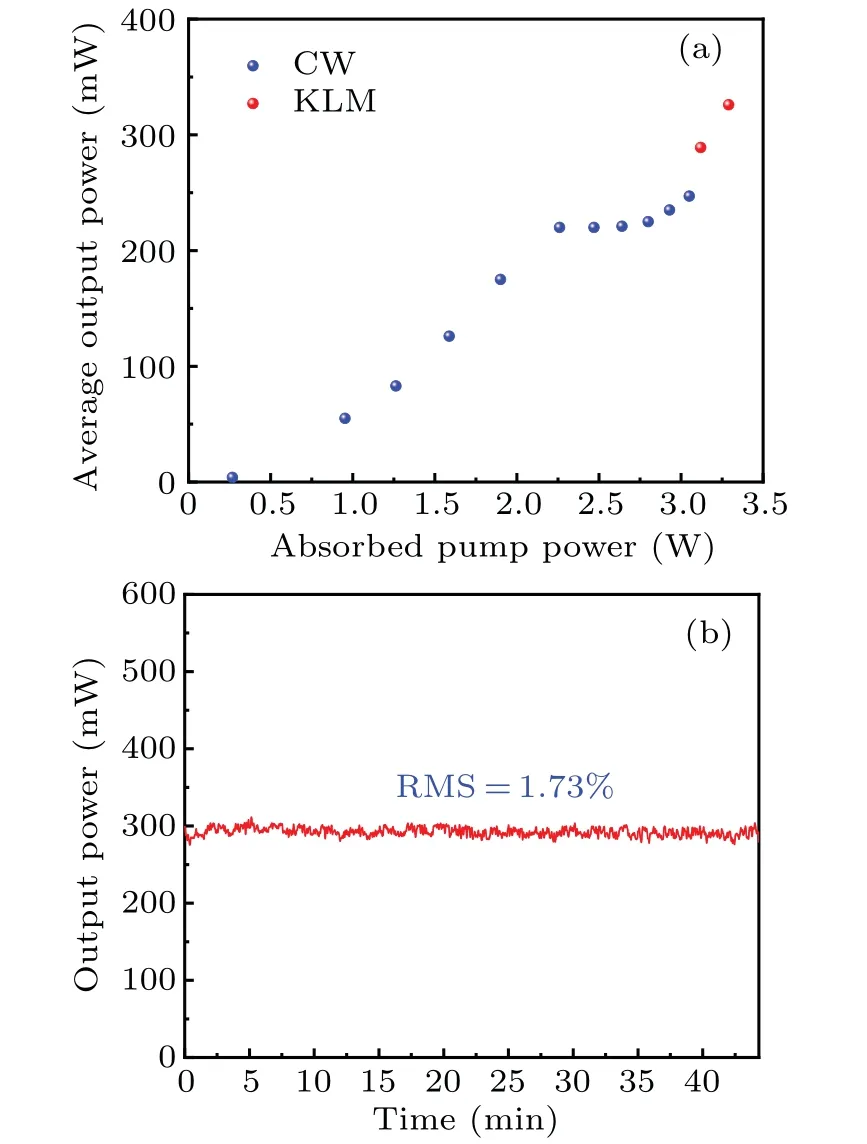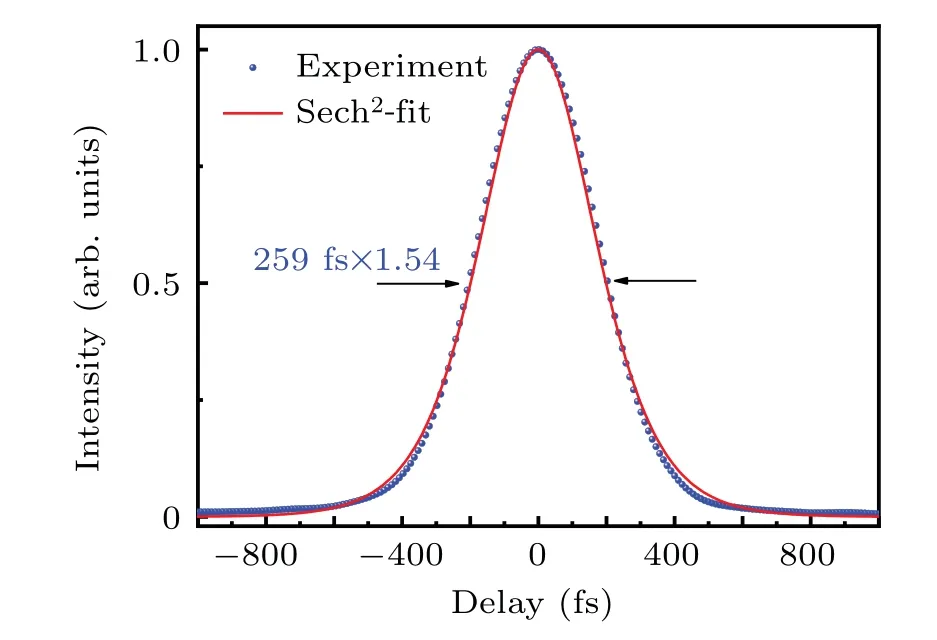Direct Kerr-lens mode-locked Tm:LuYO3 ceramic laser
Weijun Ling(令维军), Jingwen Xue(薛婧雯), Jinfang Yang(杨金芳), Chong Wang(王翀),Xiaojuan Du(杜晓娟), Wenting Wang(王文婷), Mingxia Zhang(张明霞),Feiping Lu(路飞平), Xiangbing Li(李向兵), and Zhong Dong(董忠)
1Gansu All Solid-State Laser Engineering Research Center,Tianshui 741001,China
2Engineering Research Center of Integrated Circuit Packaging and Testing,Ministry of Education,Tianshui 741001,China
3School of Electronic Information and Electrical Engineering,Tianshui Normal University,Tianshui 741001,China
Keywords: all solid-state laser,ultrashort pulse,Kerr-lens mode-locked,Tm:LuYO3 ceramic
1.Introduction
In recent years, ultrafast lasers at 2 µm based on Tm3+-doped crystals have attracted strong interest for materials processing,medical treatment,laser radar,remote sensing detection and weapons equipment applications.[1–4]At present,the main direction of development of lasers at 2 µm is to obtain output pulses with short duration and high power.[5]In particular,the generation of few-cycle mode-locking pulses is a hot research topic with many challenges.Passive mode-locking based on saturable absorbers is the most common method for generating sub-100 fs pulses.In past decades, many materials have been proven to be passive mode-locking elements for solid-state lasers at 2µm,such as graphene,[6,7]single-walled carbon nanotubes(SWCNTs),[8,9]transition metal sulfides,[10]semiconductor saturable absorber mirrors (SESAMs)[11]and so on.However, the mode-locked pulse duration is limited to the nonlinear response time of the absorbers, ranging from tens of femtoseconds to sub-picoseconds.[12,13]Therefore, passive mode-locked technology based on saturable absorbers is able to generate sub-50 fs pulses and is no longer suitable for generating shorter duration pulses.For Kerr-lens mode-locking(KLM),the nonlinear transient response time is sub-femtosecond(<1 fs)and no spectral bandwidth is limited.Thus,Kerr-lens self-mode-locking technology is the most desirable method for generating cycle pulses.
With rising research interest in 2 µm lasers, various types of Tm3+-doped laser materials have also been developed in the past years, such as lutetium aluminum garnet (LuAG),[14,15]cadmium germanium arsenide,[16]lithium lutetium fluoride,[17]calcium lithium niobium gallium garnet,[18]etc.[19]Among these, Tm3+-doped sesquioxides (Tm3+:Re2O3,Re= Lu, Y or Sc) are the most attractive gain media due to their low phonon energy and broad gain bandwidth.[20]In particular, Tm3+:Re2O3sesquioxides have a higher nonlinear refractive index that can enhance the self-phase modulation effect (SPM) to realize KLM.Thus,the pulse spectrum is broadened by SPM, supporting the generation of shorter-duration pulses.[21]Nowadays, there are many reports about 2 µm lasers based on sesquioxide media.In 2016, Ryabochkinaet al.[22]of the State University of Moldova reported the laser characteristics of Tm:Y2O3ceramic pumped by a 809 nm laser diode; the output pulses were obtained at wavelengths of 1.95 µm and 2.05 µm.Subsequently, Wanget al.[23]realized the passivelyQ-switched operation of a Tm:Y2O3ceramic laser by inserting Ho:LuAG crystal into the laser cavity.In 2017, Xuet al.[24]of Jiangsu Normal University reported for the first time a novel Tm:LuScO3mixed sesquioxide ceramic laser operating in a passivelyQ-switched regime using SWCNTs as a saturable absorber.In 2019, Stevensonet al.[25]realized 240 fs mode-locked operation of a Tm:LuScO3laser with SESAMs.Recently, a Tm:LuYO3ceramic laser operating in continuous-wave(CW)and passivelyQ-switching regimes was reported.[26]A CW laser centered at 2050 nm with a maximum output power of 1.55 W was obtained,corresponding to a slope efficiency of 19.9%.By inserting a Cr:ZnSe saturable absorber into the laser cavity, a maximum output power of 0.54 W was achieved in passiveQ-switching operation.In 2019, a Tm:LuYO3ceramic laser was demonstrated for the first time with a 41 ps pulse duration and 121 mW maximum output power using SESAMs as the saturable absorber.[27]In 2020, pulses as short as 57 fs were reported in Tm:LuYO3ceramic lasers at 2 µm with SWCNTs,which represents the shortest pulse duration generated from a mode-locked Tm:LuYO3solid-state laser.However,its maximum average power was only 63 mW.[28]
Compared with passively mode-locked technology based on saturable absorbers, KLM has the potential to further shorten the pulse duration and scale the output laser power owing to its unique advantages of broad spectral bandwidth,lower cost and not having to consider damage to the saturable absorber.[29]At present, many reports have demonstrated that various Kerr media, such as ZnSe,[30]Cr2+:ZnSe and Cr2+:ZnS,[31]could be inserted into the resonator to provide enhanced nonlinear phrase modulation during KLM operation in the mid-infrared (IR) wavelength range.However,there are a few reports on pure KLM for Tm3+-doped solidstate lasers.KLM, with its many advantages, is the best method for achieving the shortest pulse duration.However,achieving KLM in the mid-IR wavelength range is challenging due to several factors.Firstly, the magnitude of the Kerrlens effect is proportional toω-4,whereωis the cavity mode radius (which is proportional to the square root of the laser wavelength).[32]Consequently,the longer the wavelength,the weaker the Kerr effect.The Kerr effect at a wavelength of 2µm is much weaker than for 800 nm Ti:sapphire lasers and 1030 nm Yb-doped lasers.[32,33]Additionally,in order to realize KLM operation,the intracavity laser power must be greater than the self-focusing critical power,which is proportional to the square of the laser wavelength.[34,35]Therefore, the selffocusing critical power in a 2 µm laser is nearly twice as high as that of a Ti:sapphire laser and Yb-doped lasers.So far, there have been a few reports on KLM lasers at 2 µm.In 2017, Tokurakawaet al.[32]of the University of Electro-Communications reported the first KLM Tm3+-doped solidstate laser pumped by 1611 nm Er:Yb fiber master oscillator power amplifier (MOPA) laser.The absorption cross section of a Tm:Sc2O3crystal at 1.6µm is two times higher than that at 790 nm.Therefore,a shorter crystal length helps to improve the nonlinear refractive index which is beneficial to KLM.However, the application of a 2 µm ultrafast laser is limited due to the complex structure and high cost of 1.6 µm Er–Yb fiber MOPA lasers.At the same time,Canbazet al.[30]of Koc¸University realized a KLM Tm:YLF laser by inserting a ZnSe Kerr medium into the resonator.However,the maximum output power was only 14 mW due to the large absorption loss of ZnSe at 2µm,which limited its applications.Recently,Wanget al.demonstrated a KLM Tm:MgWO4laser using SWCNTs as the saturable absorber;this initiated a new direction for the 790 nm pumped 2µm KLM laser.[36]
In this paper,we report a direct KLM Tm:LuYO3ceramic laser without the aid of any nonlinear mode-locked elements.To the best of our knowledge, a Tm:LuYO3solid state laser with KLM operation has not been reported so far.The incident pump power threshold is as low as 267 mW and the pulse duration and spectral bandwidth (the full width at half maximum,FWHM)are 259 fs and 19.8 nm,respectively.The maximum output power is 326 mW and the repetition frequency is 97.1 MHz.
2.Experimental setup
The experimental setup of the KLM Tm:LuYO3ceramic laser is shown in Fig.1.A 4.8 W wavelength-tunable Ti:sapphire laser is used as the pumping source,and its emission wavelength is tuned to 796 nm to match the absorption peak of the Tm:LuYO3crystal.[27]The uncoated crystal is arranged at Brewster’s angle in order to reduce the reflection loss.The crystal is doped to 4 at.%,and it has dimensions of 3 mm×3 mm×4.4 mm.To mitigate the thermal load,the crystal is wrapped with indium foil and tightly mounted in a copper holder,which is water-cooled to 14◦C.The pump laser is focused into the gain medium by a lens L with a focal length off=150 mm,which provides transmission of more than 95%for the pump laser wavelength.Two flat mirrors(M1 and M2)are used as turning mirrors.In this configuration, the laser cavity consists of two dichroic concave mirrors M3 and M4(radii of curvature 100 mm and 75 mm, respectively), a flat mirror M5, a CaF2prism pair P1 and P2 for dispersion compensation and a flat output coupler(OC).The two flat concave mirrors M3 and M4 have a transmission of more than 99%between 770 nm and 1050 nm and broadband high reflectivity (R>99.9%) for the oscillation pulses in the range 1800–2075 nm.M5 is a plane mirror with a high-reflectivity coating(R>99.9%) from 1800 nm to 2075 nm.The prism pair P1 and P2 have a tip-to-tip separation of 25 cm,corresponding to a total group delay dispersion of∼-980 fs2per round trip at 2.05µm.A flat mirror with a transmission of 0.5%is used as an OC.The magnitude of the Kerr-lens effect is proportional toω-4,whereωis the cavity mode radius(which is proportional to the square root of the laser wavelength).Therefore,the cavity radius in mid-IR wavelengths is smaller than in near-IR wavelengths to realize KLM operation.Based on the standard ABCD matrix analysis of the cavity,the minimum beam waist spot size inside the Tm:LuYO3gain medium is estimated to be 50.5 µm during mode-locked operation.The pump beam radius at the position of the gain medium is 31µm.Therefore,we optimize the mode matching between the pump laser and the oscillating laser to improve the optical-to-optical conversion efficiency and reduce the pump threshold.[37]

Fig.1.The experimental setup of the KLM Tm:LuYO3 ceramic laser.
3.Results and discussion
With a 0.5% OC, the absorbed pump power threshold was measured to be 267 mW in CW operation, as shown in Fig.2(a).When the absorption pump power reached 3.12 W,the KLM was self-starting and the output power was 289 mW.Further increasing the pump absorption power to 3.3 W, the maximum average output power was 326 mW.The laser output characteristics of the KLM Tm:LuYO3ceramic laser are shown in Fig.2(a), where the black and blue dots represent the experimental data when operating in the CW and KLM regimes, respectively.When the pump power increased to 2.2 W, the average output power no longer increased or even slightly decreased due to the asymmetric resonator structure and the existence of two stable regions.When one stable region transited to the other, the output power dropped.When CW operation was in the second stable region, KLM operation was realized,and the output power increased significantly by about 42 mW, from 247 mW to 289 mW.As shown in Fig.2(b), we measured the long-time stability of the average output power of the Tm:LuYO3laser.The RMS stability of the laser was better than 1.73%over 40 min at the maximum output power of 326 mW.The fluctuations of output power were due to instability of mechanical parts and environmental disturbance,such as air turbulence and temperature drift.The power stability can be further improved by using high-quality mechanical parts with good performance and adding a special shell to the KLM experimental setup.
The optical spectrum of the mode-locked pulses was measured by an optical spectrum analyzer(AvaSpec-NIR256-2.5tec, Avantes).As shown in Fig.3, the optical spectrum was centered at 2053 nm with a FWHM spectral bandwidth of 19.8 nm.The typical pulse trains of KLM were recorded by a fast photodiode(ET-5000, EOT)with a digital oscilloscope(WaveRunner 8404M, LeCroy), as shown in Fig.4.The RF spectrum was measured by a RF spectrum analyzer(DSA832,RIGOL)with a photodiode detector(ET-5000, EOT).As can be seen from the radio-frequency(RF)spectrum displayed in Fig.5,the fundamental tone at 97.1 MHz was more than 58 dB above the noise floor.The RF spectrum was recorded at a resolution bandwidth of 10 kHz.The total length of the cavity was about 1.5 m,corresponding to a theoretical repetition rate of 97.1 MHz for KLM pulses,in good agreement with experimental measurements.

Fig.3.Laser spectrum of the KLM pulses from the Tm:LuYO3ceramic laser.

The pulse duration was measured by an autocorrelator(Pulse Check 150, APE).Assuming a sech2-shape pulse, the shortest pulse duration was 259 fs, as shown in Fig.6.The corresponding time–bandwidth product of 0.365 was close to the Fourier transform limit(0.315).

4.Conclusions
In conclusion, we have demonstrated KLM operation of a Tm:LuYO3ceramic laser at 2053 nm for the first time.At 4.8 W incident pump power, we obtained mode-locked femtosecond pulses as short as 259 fs at a repetition rate of 97.1 MHz, with a maximum output power of 326 mW.This result is a combination of the excellent spectral properties of Tm:LuYO3and the use of a high-brightness pumping scheme allowing pure KLM operation.The output power was limited due to the available power of the Ti:sapphire laser,and it could be improved by using a high-power diode laser at 790 nm as the pumping source.A shorter pulse duration may be achieved by further controlling the intracavity dispersion and using different output couplers with different transmittances.We believe that a Tm:LuYO3ceramic laser with KLM operation at 2.05µm is likely to be a promising ultrashort pulse source at mid-IR wavelengths.
Acknowledgements
Project supported by the National Natural Science Foundation of China (Grant Nos.62165012 and 61665010), Key research and development projects in Gansu Province (Grant No.21YFIGE300),Gansu Province College Industry Support Plan Project (Grant Nos.2020C-23 and 2022CYZC-59), Department of Education of Gansu Province: The Education Project of Open Competition for the Best Candidates (Grant No.2021jyjbgs-06), Gansu Provincial University Innovation Fund Project (Grant No.2021B-190), Qinzhou District Science and Technology Plan Project (Grant No.2021-SHFZG-1442),Gansu Province College Young Doctor Support Project(Grant No.2023QB-013), and Gansu Province Excellent Graduate Innovation Star Project (Grant No.2022CXZX-796).
- Chinese Physics B的其它文章
- Optimal zero-crossing group selection method of the absolute gravimeter based on improved auto-regressive moving average model
- Deterministic remote preparation of multi-qubit equatorial states through dissipative channels
- Direct measurement of nonlocal quantum states without approximation
- Fast and perfect state transfer in superconducting circuit with tunable coupler
- A discrete Boltzmann model with symmetric velocity discretization for compressible flow
- Dynamic modelling and chaos control for a thin plate oscillator using Bubnov–Galerkin integral method

